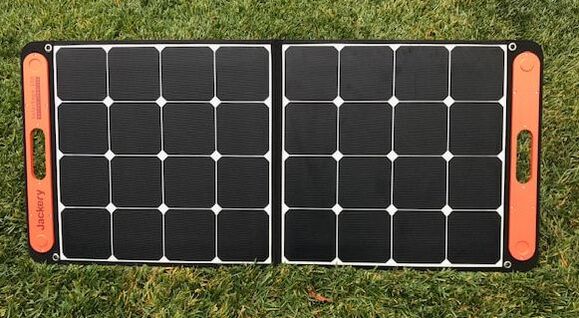 I posted a review of the Jackery 1000Wh solar generator earlier this month with my overall impression being that it is a very well designed and built power supply which can power even the hungriest astronomy setup for 8-10hrs without needing a recharge. While the Jackery can be recharged fastest with an AC outlet using the supplied charging cable, it can also be recharged quickly during the day using Jackery's Solar Saga 100w solar panels. Here I review the results of over a month's testing of a pair of 100w solar panels along with the generator both at my home observatory and during a 3 night trip to a dark site. 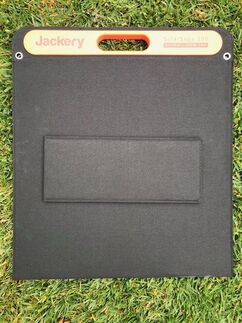 Jackery makes two versions of their solar panels, a 60w and a 100w model. While I tested a pair of the 100w models, they share design features with the 60w model as described here with the differences being size, weight and power output. Both panels use Monocrystalline solar cells with up to 23% efficiency and a voltage output of 18V and a current of 5.55A. The panels have over voltage, short circuit and surge protection built in. They have an operating temperature range of 14 deg F to 149 deg F. They come with a 24 month warranty but an included registration card will extend that to 36 months. The 100w panel is 48in x 21in x 0.2in when fully extended to capture the sun's rays. For transport and storage it conveniently folds in half. A pair of magnets cleverly embedded in plastic at two corners of the panel help to keep the panel folded when not in use or during transport. It also has a built in rubber carrying handle and weighs only 9.1lbs. All of these smart design features make it very easy to transport and set up in the field. 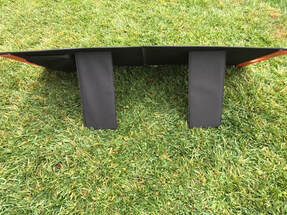 Each half of the full panel has a kickstand which stays put with velcro for travel and can be extended to support the panel when charging. The panels have a protective laminate layer for dust and weather resistance. A zippered pouch on the backside holds the 3m charging cable which is hard wired to the panel. The 8mm connector on the other end plugs into the charging port on the Jackery when charging the generator. Each panel also has a 5V 2.4A USB-A and a 5V 3A USB-C charging port on the backside so that a cell phone or tablet can be charged directly from the panel with the proper charging cable. Overall, I am impressed with the quality of the build and cleverness of the design making it easy to use. I give Jackery an A+ for design smarts and convenience.  I ran a series of tests with the 1000Wh solar generator using my typical astrophotography imaging setup over 4 weeks at my home observatory and in a three night field test at a dark site location. In between tests I had multiple occasions to recharge the generator with the pair of 100w solar panels under varying sky conditions including best (full sun) and worst (overcast) case skies along with the in between cases of partial sun and clouds. To use two solar panels a Y adapter cable which is supplied with the 1000Wh generator is used to combine the outputs of both solar panels which are then fed into the generator's input port. It is not absolutely necessary to use both solar panels but the recharging time will be significantly reduced with two panels instead of one. I should point out that all of these took place in late September and early October as we moved into fall and the sun is lower in the sky and the days are roughly 11hrs long. The first thing I checked was the output of each solar panel. Keep in mind the output power of a solar panel varies with sun intensity and angle of the panel relative to the suns rays. Maximum output is seldom achieved, and when it is it is not sustained over long periods unless you re-align the panel due to changing solar intensity and angle. The meter on the Jackery 1000Wh generator showed that panel #1 was charging at a rate of 87/88w on a sunny day which is well within what other reviews have shown. Next I tested the second panel but its output was only 42/43w. Clearly the second panel was not performing up to spec. I contacted Jackery and they made arrangements for the second panel to be returned to them and a new one sent in its place, but since I was headed to a dark site for new moon in a week I asked them to wait until after my excursion to replace the second panel and forged ahead with the panels I had on hand. On a very sunny day the input to the generator with the pair of panels connected in parallel with the Y adapter cable varied from 118w to 125w over the course of the day as it charged from 20% to 100% in just 7 hrs. This rate of charge says that it should take ~ 8.75hrs to fully recharge the battery from 0% to 100%, which is in line with the advertised time of 8hrs. Not all days will be sunny so I checked how well the panels worked during several days with very little direct sunlight. The second solar recharge took place during the massive CA wildfires including three of the largest in the state's history very close to my home. With smoke filled hazy skies the entire day, the panels were able to recharge from a SOC of 23% to 100% in approximately 9.5hrs. The input to the solar generator typically read between 80w and 90w for much of the day. Apparently, enough UV light made it through the smoke particles in the sky. I was quite surprised. For the third solar recharge I picked a day with periods of partial sun, high thin clouds, but mostly a steady overcast condition. The output power of the panels fluctuated from 0w to 122w but hovered mostly around 22-48w throughout the day. In this case the two 100w panels could only provide enough power to recharge the generator from 18% SOC to 67% SOC in 9 hours. The Jackery panels are not unique in this regards as no solar panel can provide much output if the sun doesn't shine. But I was impressed that even under these gloomy skies I was able to recharge the generator by almost 50%. Odds are that if the day is that overcast we would not expect a clear night for astronomy so this would not be a problem. The charging rate was very linear with the SOC increasing just over 9% per hour of solar exposure up until the final 1% percent. This is nice in that, if the sky conditions are expected to remain fixed throughout the day, one can make a fairly accurate estimate of how long it will take to recharge under different sky conditions. 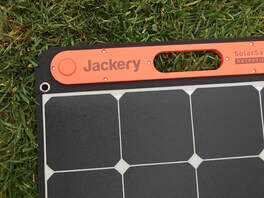 During my 3 night field trip to do astrophotography during the new moon I had the opportunity to recharge the panels after the first two nights. The first night I spent 8 hours imaging resulting in the generator dropping to 28% SOC. With full sun the next day I was able to fully recharge the generator as well as top off my laptop battery with Jackery's pass through charging option in a bit over 6 hours. Pass through charging allows the generator to be recharged at the same time it is supplying power to a load. The second night I imaged for only 6 hours and was easily able to recharge the generator in less than 6 hours in full sun. With this setup I could have easily imaged 8 hours a night indefinitely, fully recharging the generator, laptop and my cell phone during the day with the solar panels so long as I had ~7 hours of sunshine. Once I returned from my field trip I returned the under performing panel to Jackery with a prepaid voucher and quickly received a replacement. The first thing I did was to test it against the first panel under fully sunny skies. This time both panels consistently output 96/97w of power in tests on two different sunny days. This is exceptionally high compared to what I have read for any 100w solar panels on the market. Obviously the sun's intensity and angle or both are extremely important to obtaining maximum power output. I could easily improve the output by ~10w carefully adjusting the azimuth and angle of the panels. Next I checked the output with the pair of panels connected in parallel with the Y adapter. The configuration produced 129w of input power to the generator which remained steady over time. Why not 192W you might ask yourself. If you read my review of the solar generator you will see that with the supplied AC adapter the input power was 164w. Then why the difference with the two 100w panels? Well, I read in one review that the Jackery limits the total input current and since the AC adapter supplies current at 24V that would mean that the current limit is 164w/24V = ~7A. Considering that the solar panels supply current at 18V, and assuming the same current limit of 7A that would set the maximum input power at 18V x 7A = 126W which is very close to what I measured. The net result is that one does not get the full advantage of the two 100w solar panels due to this current limitation which is disappointing. The input power limit of ~126w led me to the next test measuring the total recharge time with a single 100w panel. I monitored the panel output hourly and used that opportunity to adjust the position of the panel to maximize its output, thereby keeping above 90w for most of the time. Since the days are shorter now and the sun is lower in the sky I had to run the test over two days to fully recharge the generator from 1% to 99% SOC. It took a total of 10.5hrs to recharge completely, which is a rate of 9.3% per hour and the rate was very steady all the way up until 99%. 9.3% of 1000w is 93w which is consistent with my observation of the fact that the output remained above 90w for most of the charging period. Also, 93w x 10.5hr = 977Wh which is also consistent with the fact that the SOC went from 1% to 99%, or 98% of 1000Wh = 980Wh. So, I suspect that during the typical star party season with the sun rising earlier and setting later than it does in Nov, one could fully recharge the 1000Wh generator with a single panel in one day. Overall, I was suitably impressed with the build quality, design smarts and obvious capabilities of the Jackery Solar Saga 100. My truly on complaint is the price. At a price of $299.99 the Jackery 100w solar panels are more expensive than other folding panels. However, none of the other folding panels I have reviewed on line appear to have as durable, compact and ergonomic design as the Jackery. Nonetheless, it is best to keep an eye out for one of Jackery's sales to get the best possible price. Summary Pros High efficiency solar cells Lightweight with handles Sturdy, durable design Embedded USB charging ports Cons Price No protective case Hard wired charging cable You can shop for Jackery products at Amazon.com. Links are Amazon Associate links. Jackery Solar Saga 100 amzn.to/48XXdyk Edit: You can find a video version of my Jackery 1000 and 500 review on YouTube
1 Comment
|
Categories
All
Archives
January 2024
|
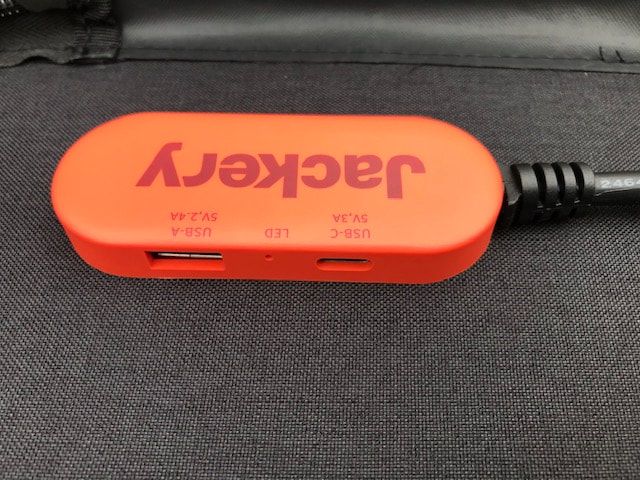
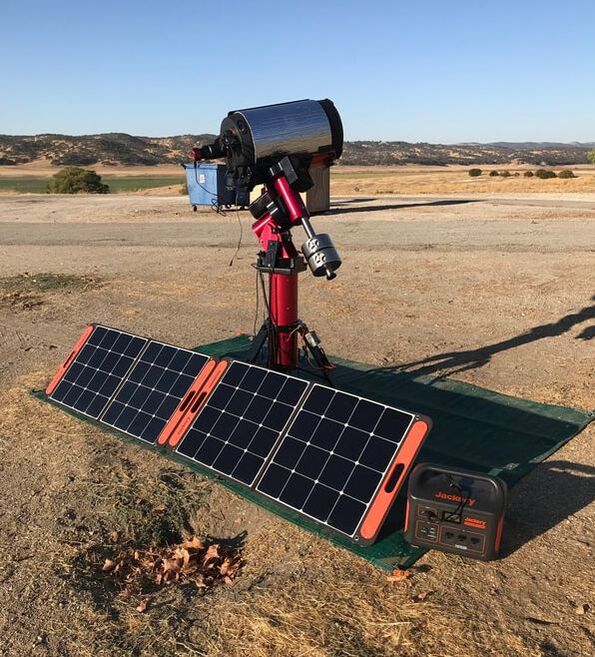
 RSS Feed
RSS Feed